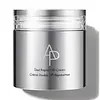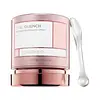What's inside
What's inside
 Key Ingredients
Key Ingredients

 Benefits
Benefits

 Concerns
Concerns

 Ingredients Side-by-side
Ingredients Side-by-side

Water
Skin ConditioningLactobacillus Ferment Lysate
Skin ConditioningGlycerin
HumectantPropanediol
SolventDimethicone
EmollientBetaine
HumectantDipropylene Glycol
HumectantIsododecane
EmollientCeramide NP
Skin ConditioningSynthetic Wax
Abrasive1,2-Hexanediol
Skin ConditioningLauryl PEG-9 Polydimethylsiloxyethyl Dimethicone
Skin ConditioningPEG-15/Lauryl Dimethicone Crosspolymer
StabilisingLactobacillus Ferment
Skin ConditioningButylene Glycol
HumectantSodium Chloride
MaskingPanthenol
Skin ConditioningPEG-10 Dimethicone
Skin ConditioningMagnesium Sulfate
Candelilla Wax Esters
Polysilicone-11
Propylene Glycol
HumectantPolymethylsilsesquioxane
Hydroxypropyl Starch Phosphate
Nylon-12
CI 77891
Cosmetic ColorantRicinus Communis Seed Oil
MaskingEthylhexylglycerin
Skin ConditioningCopernicia Cerifera Wax
Disodium EDTA
Dimethiconol
EmollientAdenosine
Skin ConditioningMadecassoside
AntioxidantLauroyl Lysine
Skin ConditioningPogostemon Cablin Leaf Oil
MaskingBioflavonoids
Skin ConditioningAlumina
AbrasiveSantalum Album Oil
MaskingSaccharomyces Polypeptides
Skin ConditioningTocopherol
AntioxidantBoswellia Carterii Gum Extract
PerfumingRosmarinus Officinalis Leaf Oil
MaskingJasminum Sambac Flower Extract
MaskingCitrus Aurantium Dulcis Flower Oil
AstringentChamomilla Recutita Flower Oil
MaskingCopper Tripeptide-1
Skin ConditioningSodium Rna
Skin ConditioningCitrus Aurantium Amara Flower Extract
RefreshingVanilla Planifolia Fruit Extract
Skin ConditioningMentha Viridis Leaf Oil
AstringentOsmanthus Fragrans Flower Extract
MaskingHibiscus Abelmoschus Seed Extract
MaskingWater, Lactobacillus Ferment Lysate, Glycerin, Propanediol, Dimethicone, Betaine, Dipropylene Glycol, Isododecane, Ceramide NP, Synthetic Wax, 1,2-Hexanediol, Lauryl PEG-9 Polydimethylsiloxyethyl Dimethicone, PEG-15/Lauryl Dimethicone Crosspolymer, Lactobacillus Ferment, Butylene Glycol, Sodium Chloride, Panthenol, PEG-10 Dimethicone, Magnesium Sulfate, Candelilla Wax Esters, Polysilicone-11, Propylene Glycol, Polymethylsilsesquioxane, Hydroxypropyl Starch Phosphate, Nylon-12, CI 77891, Ricinus Communis Seed Oil, Ethylhexylglycerin, Copernicia Cerifera Wax, Disodium EDTA, Dimethiconol, Adenosine, Madecassoside, Lauroyl Lysine, Pogostemon Cablin Leaf Oil, Bioflavonoids, Alumina, Santalum Album Oil, Saccharomyces Polypeptides, Tocopherol, Boswellia Carterii Gum Extract, Rosmarinus Officinalis Leaf Oil, Jasminum Sambac Flower Extract, Citrus Aurantium Dulcis Flower Oil, Chamomilla Recutita Flower Oil, Copper Tripeptide-1, Sodium Rna, Citrus Aurantium Amara Flower Extract, Vanilla Planifolia Fruit Extract, Mentha Viridis Leaf Oil, Osmanthus Fragrans Flower Extract, Hibiscus Abelmoschus Seed Extract
Water
Skin ConditioningDimethicone
EmollientHydrogenated Polyisobutene
EmollientGlycerin
HumectantC12-15 Alkyl Benzoate
AntimicrobialHelianthus Annuus Seed Oil Unsaponifiables
EmollientBis-PEG-18 Methyl Ether Dimethyl Silane
EmollientSodium Lauroyl Lactylate
EmulsifyingIsododecane
EmollientBeeswax
Emulsion StabilisingDimethicone/PEG-10/15 Crosspolymer
Lauryl PEG-9 Polydimethylsiloxyethyl Dimethicone
Skin ConditioningDimethicone/Vinyl Dimethicone Crosspolymer
Skin ConditioningButylene Glycol
HumectantPhytosphingosine
Skin ConditioningCeramide Ng
Skin ConditioningCeramide AP
Skin ConditioningCholesterol
EmollientCeramide NP
Skin ConditioningPalmitoyl Hexapeptide-12
Skin ConditioningCeramide EOP
Skin ConditioningTribehenin
EmollientPEG/PPG-18/18 Dimethicone
EmulsifyingPEG-10 Dimethicone
Skin ConditioningDisteardimonium Hectorite
StabilisingDisodium EDTA
Sodium Chloride
MaskingPhenoxyethanol
PreservativeSilica
AbrasiveCarbomer
Emulsion StabilisingPropylene Carbonate
SolventXanthan Gum
EmulsifyingParfum
MaskingPEG-10 Rapeseed Sterol
CleansingBenzoic Acid
MaskingSorbic Acid
PreservativeChlorphenesin
AntimicrobialLactic Acid
BufferingDipropylene Glycol
HumectantEthylhexylglycerin
Skin ConditioningTocopherol
AntioxidantWater, Dimethicone, Hydrogenated Polyisobutene, Glycerin, C12-15 Alkyl Benzoate, Helianthus Annuus Seed Oil Unsaponifiables, Bis-PEG-18 Methyl Ether Dimethyl Silane, Sodium Lauroyl Lactylate, Isododecane, Beeswax, Dimethicone/PEG-10/15 Crosspolymer, Lauryl PEG-9 Polydimethylsiloxyethyl Dimethicone, Dimethicone/Vinyl Dimethicone Crosspolymer, Butylene Glycol, Phytosphingosine, Ceramide Ng, Ceramide AP, Cholesterol, Ceramide NP, Palmitoyl Hexapeptide-12, Ceramide EOP, Tribehenin, PEG/PPG-18/18 Dimethicone, PEG-10 Dimethicone, Disteardimonium Hectorite, Disodium EDTA, Sodium Chloride, Phenoxyethanol, Silica, Carbomer, Propylene Carbonate, Xanthan Gum, Parfum, PEG-10 Rapeseed Sterol, Benzoic Acid, Sorbic Acid, Chlorphenesin, Lactic Acid, Dipropylene Glycol, Ethylhexylglycerin, Tocopherol
Ingredients Explained
These ingredients are found in both products.
Ingredients higher up in an ingredient list are typically present in a larger amount.
Butylene Glycol (or BG) is used within cosmetic products for a few different reasons:
Overall, Butylene Glycol is a safe and well-rounded ingredient that works well with other ingredients.
Though this ingredient works well with most skin types, some people with sensitive skin may experience a reaction such as allergic rashes, closed comedones, or itchiness.
Learn more about Butylene GlycolCeramide NP is a type of ceramide and formally known as ceramide 3.
Ceramides are intercellular lipids naturally found in our skin that bonds dead skin cells together to create a barrier. They are known for their ability to hold water and thus are a great ingredient for dry skin.
Ceramides are an important building block for our skin barrier. A stronger barrier helps the skin look more firm and hydrated. By bolstering the skin ceramides act as a barrier against irritating ingredients. This can help with inflammation as well.
If you would like to eat ceramides, sweet potatoes contain a small amount.
Read more about other common types of ceramides here:
Ceramide AP
Ceramide EOP
Dimethicone is a type of synthetic silicone created from natural materials such as quartz.
What it does:
Dimethicone comes in different viscosities:
Depending on the viscosity, dimethicone has different properties.
Ingredients lists don't always show which type is used, so we recommend reaching out to the brand if you have questions about the viscosity.
This ingredient is unlikely to cause irritation because it does not get absorbed into skin. However, people with silicone allergies should be careful about using this ingredient.
Note: Dimethicone may contribute to pilling. This is because it is not oil or water soluble, so pilling may occur when layered with products. When mixed with heavy oils in a formula, the outcome is also quite greasy.
Learn more about DimethiconeDipropylene Glycol is a synthetically created humectant, stabilizer, and solvent.
This ingredient helps:
Dipropylene glycol is technically an alcohol, but it belongs to the glycol family (often considered part of the ‘good’ alcohols). This means it is hydrating and gentle on skin unlike drying solvent alcohols like denatured alcohol.
As a masking agent, Dipropylene Glycol can be used to cover the smell of other ingredients. However, it does not have a scent.
Studies show Dipropylene Glycol is considered safe to use in skincare.
Learn more about Dipropylene GlycolDisodium EDTA plays a role in making products more stable by aiding other preservatives.
It is a chelating agent, meaning it neutralizes metal ions that may be found in a product.
Disodium EDTA is a salt of edetic acid and is found to be safe in cosmetic ingredients.
Learn more about Disodium EDTAEthylhexylglycerin (we can't pronounce this either) is commonly used as a preservative and skin softener. It is derived from glyceryl.
You might see Ethylhexylglycerin often paired with other preservatives such as phenoxyethanol. Ethylhexylglycerin has been found to increase the effectiveness of these other preservatives.
Glycerin is already naturally found in your skin. It helps moisturize and protect your skin.
A study from 2016 found glycerin to be more effective as a humectant than AHAs and hyaluronic acid.
As a humectant, it helps the skin stay hydrated by pulling moisture to your skin. The low molecular weight of glycerin allows it to pull moisture into the deeper layers of your skin.
Hydrated skin improves your skin barrier; Your skin barrier helps protect against irritants and bacteria.
Glycerin has also been found to have antimicrobial and antiviral properties. Due to these properties, glycerin is often used in wound and burn treatments.
In cosmetics, glycerin is usually derived from plants such as soybean or palm. However, it can also be sourced from animals, such as tallow or animal fat.
This ingredient is organic, colorless, odorless, and non-toxic.
Glycerin is the name for this ingredient in American English. British English uses Glycerol/Glycerine.
Learn more about GlycerinIsododecane is a fragrance, emollient, and solvent.
As an emollient, it helps your skin stay soft and hydrated. Emollients help trap moisture into your skin.
Isododecane's role as a solvent makes it a great texture enhancer. It spreads smoothly on skin and does not leave a sticky feeling behind. Isododecane also helps prevent color transfer in makeup products.
Isododecane is not absorbed into skin.
Learn more about IsododecaneLauryl PEG-9 Polydimethylsiloxyethyl Dimethicone is a type of silicone.
Peg-10 Dimethicone is silicone with conditioner and emulsifier properties. It mostly acts as an emollient in skincare and and humectant in haircare.
According to the manufacturer, acidic formulations decrease the stability of this ingredient. It works best in neutral or near neutral formulations.
Chances are, you eat sodium chloride every day. Sodium Chloride is also known as table salt.
This ingredient has many purposes in skincare: thickener, emulsifier, and exfoliator.
You'll most likely find this ingredient in cleansers where it is used to create a gel-like texture. As an emulsifier, it also prevents ingredients from separating.
There is much debate on whether this ingredient is comedogenic. The short answer - comedogenic ratings don't tell the whole story. Learn more about comegodenic ratings here.
The concensus about this ingredient causing acne seems to be divided. Research is needed to understand if this ingredient does cause acne.
Scrubs may use salt as the primary exfoliating ingredient.
Learn more about Sodium ChlorideTocopherol (also known as Vitamin E) is a common antioxidant used to help protect the skin from free-radicals and strengthen the skin barrier. It's also fat soluble - this means our skin is great at absorbing it.
Vitamin E also helps keep your natural skin lipids healthy. Your lipid skin barrier naturally consists of lipids, ceramides, and fatty acids. Vitamin E offers extra protection for your skin’s lipid barrier, keeping your skin healthy and nourished.
Another benefit is a bit of UV protection. Vitamin E helps reduce the damage caused by UVB rays. (It should not replace your sunscreen). Combining it with Vitamin C can decrease sunburned cells and hyperpigmentation after UV exposure.
You might have noticed Vitamin E + C often paired together. This is because it is great at stabilizing Vitamin C. Using the two together helps increase the effectiveness of both ingredients.
There are often claims that Vitamin E can reduce/prevent scarring, but these claims haven't been confirmed by scientific research.
Learn more about TocopherolWater. It's the most common cosmetic ingredient of all. You'll usually see it at the top of ingredient lists, meaning that it makes up the largest part of the product.
So why is it so popular? Water most often acts as a solvent - this means that it helps dissolve other ingredients into the formulation.
You'll also recognize water as that liquid we all need to stay alive. If you see this, drink a glass of water. Stay hydrated!
Learn more about Water